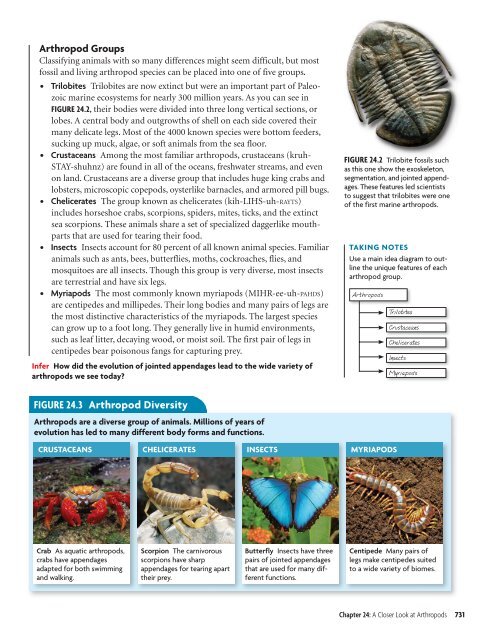24 A Closer Look at Arthropods
24 A Closer Look at Arthropods
24 A Closer Look at Arthropods
You also want an ePaper? Increase the reach of your titles
YUMPU automatically turns print PDFs into web optimized ePapers that Google loves.
Arthropod Groups<br />
Classifying animals with so many differences might seem difficult, but most<br />
fossil and living arthropod species can be placed into one of five groups.<br />
• Trilobites Trilobites are now extinct but were an important part of Paleozoic<br />
marine ecosystems for nearly 300 million years. As you can see in<br />
FIGURE <strong>24</strong>.2, their bodies were divided into three long vertical sections, or<br />
lobes. A central body and outgrowths of shell on each side covered their<br />
many delic<strong>at</strong>e legs. Most of the 4000 known species were bottom feeders,<br />
sucking up muck, algae, or soft animals from the sea floor.<br />
• Crustaceans Among the most familiar arthropods, crustaceans (kruh-<br />
STAY-shuhnz) are found in all of the oceans, freshw<strong>at</strong>er streams, and even<br />
on land. Crustaceans are a diverse group th<strong>at</strong> includes huge king crabs and<br />
lobsters, microscopic copepods, oysterlike barnacles, and armored pill bugs.<br />
• Chelicer<strong>at</strong>es The group known as chelicer<strong>at</strong>es (kih-LIHS-uh-RAYTS)<br />
includes horseshoe crabs, scorpions, spiders, mites, ticks, and the extinct<br />
sea scorpions. These animals share a set of specialized daggerlike mouthparts<br />
th<strong>at</strong> are used for tearing their food.<br />
• Insects Insects account for 80 percent of all known animal species. Familiar<br />
animals such as ants, bees, butterflies, moths, cockroaches, flies, and<br />
mosquitoes are all insects. Though this group is very diverse, most insects<br />
are terrestrial and have six legs.<br />
• Myriapods The most commonly known myriapods (MIHR-ee-uh-PAHDS)<br />
are centipedes and millipedes. Their long bodies and many pairs of legs are<br />
the most distinctive characteristics of the myriapods. The largest species<br />
can grow up to a foot long. They generally live in humid environments,<br />
such as leaf litter, decaying wood, or moist soil. The first pair of legs in<br />
centipedes bear poisonous fangs for capturing prey.<br />
Infer How did the evolution of jointed appendages lead to the wide variety of<br />
arthropods we see today?<br />
FIGURE <strong>24</strong>.2 Trilobite fossils such<br />
as this one show the exoskeleton,<br />
segment<strong>at</strong>ion, and jointed appendages.<br />
These fe<strong>at</strong>ures led scientists<br />
to suggest th<strong>at</strong> trilobites were one<br />
of the first marine arthropods.<br />
TAKING NOTES<br />
Use a main idea diagram to outline<br />
the unique fe<strong>at</strong>ures of each<br />
arthropod group.<br />
<strong>Arthropods</strong><br />
Trilobites<br />
Crustaceans<br />
Chelicer<strong>at</strong>es<br />
Insects<br />
Myriapods<br />
FIGURE <strong>24</strong>.3 Arthropod Diversity<br />
<strong>Arthropods</strong> are a diverse group of animals. Millions of years of<br />
evolution has led to many different body forms and functions.<br />
CRUSTACEANS<br />
CHELICERATES<br />
INSECTS<br />
MYRIAPODS<br />
Crab As aqu<strong>at</strong>ic arthropods,<br />
crabs have appendages<br />
adapted for both swimming<br />
and walking.<br />
Scorpion The carnivorous<br />
scorpions have sharp<br />
appendages for tearing apart<br />
their prey.<br />
Butterfly Insects have three<br />
pairs of jointed appendages<br />
th<strong>at</strong> are used for many different<br />
functions.<br />
Centipede Many pairs of<br />
legs make centipedes suited<br />
to a wide variety of biomes.<br />
Chapter <strong>24</strong>: A <strong>Closer</strong> <strong>Look</strong> <strong>at</strong> <strong>Arthropods</strong> 731

















